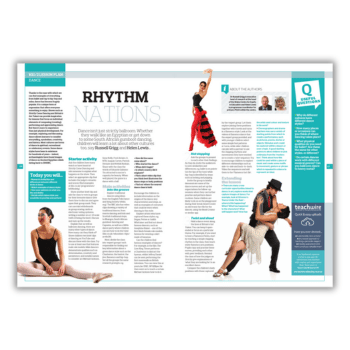Dance isn’t just strictly ballroom. Whether they walk like an Egyptian or get down to some South African gumboot dancing, children will learn a lot about other cultures too with this traditional dance lesson plan…
Thanks to the ease with which we can find examples of everything from ballet and tap to hip-hop and salsa, dance has become hugely popular.
But there’s more to experience than just physical development. For example, exploring and discussing dancing in PE allows learners to consider storytelling, symbolism, creativity, and history.
Most cultures use forms of dance in spiritual, recreational or celebratory events. Some dance styles have been in existence for hundreds of years.
Traditional dance learning objectives
- Research similarities and differences between different kinds of traditional dance
- Watch examples of traditional dance styles
- Give your opinions on what you like and dislike
- Decide which traditional dance style you would like to practise and perform
Starter activity
Ask the children how many watch or have heard of Strictly Come Dancing and ask someone to explain what happens on the show. Then select an appropriate clip that includes the judge’s remarks and scores.
Show another brief clip and ask the class to vote in groups for their favourite dance. Give them time to discuss and agree upon their group mark.
They can use mini whiteboards as group scoring cards or electronic voting systems, writing a number on a 1-10 scale (with 10 being the best). Discuss and sum up the results.
Explain that as well as ballroom dancing, there are many other types of dance. How many can they think of?
Show children two brief clips of dancing on YouTube and discuss these with the class. Try to use at least one that features male role models.
Male dancers demonstrate qualities such as determination, creativity and persistence, and notable names to consider are Gene Kelly, Fred Astaire, Jr, NTR, Joaquín Cortés, Patrick Swayze and Hrithik Roshan.
Share with the class the words of Eduardo Galeano: ‘I’m attracted to soccer’s capacity for beauty. When well played, the game is a dance with a ball’.
Dr Russell Grigg is executive head of research at the head of the Wales Centre for Equity in Education and Helen Lewis is programme coordinator for primary PGCE within the centre.














